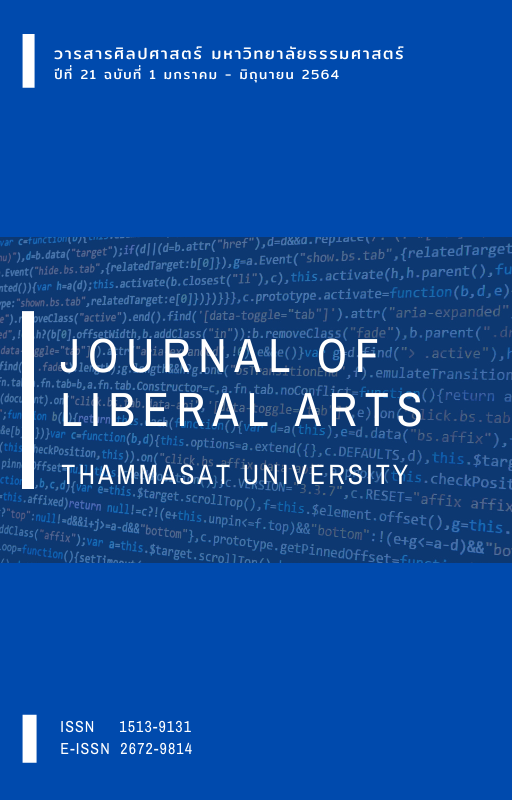การเปรียบเทียบเสียงผู้พูดภาษาไทยด้วยระยะทางแบบยูคลิก: กรณีศึกษาค่าทางกลสัทศาสตร์ด้านระยะเวลา
Main Article Content
บทคัดย่อ
การวิจัยครั้งนี้มีวัตถุประสงค์เพื่อที่จะศึกษาว่าพารามิเตอร์ด้านระยะสามารถใช้เปรียบเทียบเสียงผู้พูดในภาษาไทยได้หรือไม่ ผู้วิจัยเลือกใช้การวัดระยะทางแบบยูคลิกในการเปรียบเทียบเสียงผู้พูด โดยมีสมมติฐานว่าเสียงที่พูดด้วยผู้พูดคนเดียวกันจะมีระยะห่างของค่าพารามิเตอร์น้อยกว่าเสียงที่พูดโดยผู้พูดคนละคนกัน ผู้วิจัยเลือกศึกษาพารามิเตอร์ด้านระยะเวลา 3 พารามิเตอร์ ได้แก่ ∆C, ∆V และ %V ผู้วิจัยเก็บข้อมูลด้วยการสัมภาษณ์ผู้บอกภาษา 10 คน โดยเก็บข้อมูลเสียงที่มีลักษณะเป็นคำพูดต่อเนื่อง ผลการวิจัยพบว่าระยะทางของค่าพารามิเตอร์ด้านระยะเวลาที่พูดโดยผู้พูดคนเดียวกันมีค่าอยู่ระหว่าง 0.005 - 0.063 ในขณะที่เสียงที่พูดโดยผู้พูดคนละคนกันค่าจะอยู่ระหว่าง 0.402 - 8.456 ซึ่งสอดคล้องกับสมมติฐานของผู้วิจัย แสดงให้เห็นว่าพารามิเตอร์ด้านระยะเวลามีประสิทธิภาพในการเปรียบเทียบเสียงผู้พูดในภาษาไทยได้
Downloads
Article Details

อนุญาตภายใต้เงื่อนไข Creative Commons Attribution-NonCommercial-NoDerivatives 4.0 International License.
เอกสารอ้างอิง
จรัญ ภักดีธนากุล. (2561). กฎหมายลักษณะพยานหลักฐาน (พิมพ์ครั้งที่ 13). กรุงเทพฯ: สำนักอบรมศึกษากฎหมายแห่งเนติบัณฑิตยสภา.
Byrne, C., & Foulkes, P. (2004). The ‘mobile phone effect’ on vowel formants. Journal of Speech Language and the Law, 11(1), 83-102.
Cahn, J. E. (1990). The generation of affect in synthesized speech. Journal of the American Voice I/O Society, electronic Publication: https://eprints.kfupm.edu.sa/70011/1/70011.pdf
Dellwo, V. (2006). Rhythm and speech rate: a variation coefficient for _C. Language and Language-processing. In P. Karnowski, & I. Szigeti (Eds). Frankfurt am Main: Peter Lang, pp. 231-241.
Dellwo, V. (2010). Influences of speech rate on the acoustic correlates of speech rhythm: An experimental phonetic study based on acoustic and perceptual evidence (Doctoral Dissertation). University of Bonn.
Dellwo, V., & Koreman, J. (2008). How speaker idiosyncratic is acoustically measurable speech rhythm?, Electronic Proceedings of the annual meeting of the International Association of Forensic Phonetics and Acoustics (IAFPA), Lausanne/Switzerland.
Grabe, E., & Low, E. L. (2002). Durational variability in speech and the rhythm class hypothesis, in Papers in Laboratory Phonology 7. In C. Gussenhoven, & N. Warner (Eds.). Berlin, New York: Mouton de Gruyter.
Hollien, H. (2002). Forensic voice identification. London: Taylor and Francis.
Hove, I., & Dellwo, V., (2012). The effect of articulatory obstruction on temporal characteristics of speech. Abstract Presented at the IAFPA Conference 2012, Santander.
Jessen, M. (2007). Forensic reference data on articulation rate in German. Science and Justice, (47), 50–67.
Laan, G. (1997). The contribution of intonation, segmental durations, and spectral features to the perception of a spontaneous and a read speaking style. Speech Communication, 22, 43-65.
Leemann, A., Kolly, M.-J., & Dellwo, V. (2014). Speaker-individuality in suprasegmental temporal features: Implications for forensic voice comparison. Forensic Science International, 238, 59–67.
Nolan, F. (2009). The Phonetic Bases of Forensic Speaker Identification (2nd ed.) CUP: Cambridge.
Pingjai, S., & Ishihara, S. (2013). Forensic voice comparison in Thai: a likelihood ratio-based approach using tonal acoustics. Journal of Humanities Naresuan University, 9(13), 51-66.
Ramus, F., Nespor, M., & Mehler, J. (1999). Correlates of linguistic rhythm in the speech signal. Cognition, 73, 265-292.
Rose, P. (2002). Forensic speaker identification. London: Taylor and Francis.
Segundo, E., San, Tsanas, A., & Gómez-Vilda, P. (2017). Euclidean Distances as measures of speaker similarity including identical twin pairs: A forensic investigation using source and filter voice characteristics. Forensic Science International, (270), 25-38.
Singh, M. K., Singh, N., & Singh, A. K. (2019) Speaker's voice characteristics and similarity measurement using Euclidean Distances, International Conference on Signal Processing and Communication (ICSC), NOIDA, India, 2019, (pp. 317-322), doi: 10.1109/ICSC45622.2019.8938366.
White, L., & Mattys, S. (2007). Calibrating rhythm: first language and second language studies. Journal of Phonetics, 35, 501-522.
Wiget, L., White, L., Schuppler, B., Grenon, I., Rauch, O., & Mattys, S. L. (2010). How stable are acoustic metrics of contrastive speech rhythm? Journal of the Acoustical Society of America, 127, 1559-1569.
Yoon, T. J. (2010) Capturing inter-speaker invariance using statistical measures of speech rhythm, Proceedings of Speech Prosody, 5, Chicago.
Taitechawat, S., & Foulkes, P. (2011). Discrimination of speakers using tone and formant dynamics in Thai. Proceeing of 17th International Congress of Phonetic Sciences (ICPhS), pp.1975–1981.
Thakur, A. S., & Sahayam, N. (2013). Speech recognition using Euclidean Distance. International Journal of Emerging Technology and Advanced Engineering, 3(3), 587-590.


